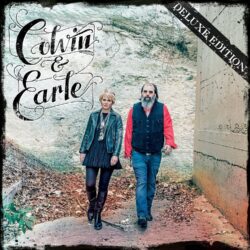
 Shawn Colvin and Steve Earle discovered they had a lot more in common than being respected recording artists in the Americana and folk genres. They both have struggled with addiction (Earle heroin and a smorgasbord of other substances; Colvin mainly alcohol) and appeared to be winning the battle on points at the time of their duo recording in 2016. Both had also experienced the pain of divorce – Earle leading Colvin 7-2 at the time, with both swearing off any more marriages. Eight years later, both musicians remain clean and single. Bravo!
Shawn Colvin and Steve Earle discovered they had a lot more in common than being respected recording artists in the Americana and folk genres. They both have struggled with addiction (Earle heroin and a smorgasbord of other substances; Colvin mainly alcohol) and appeared to be winning the battle on points at the time of their duo recording in 2016. Both had also experienced the pain of divorce – Earle leading Colvin 7-2 at the time, with both swearing off any more marriages. Eight years later, both musicians remain clean and single. Bravo!
The ”Colvin & Earle” album came about when she got the idea that they should collaborate on some shows together. Colvin had done a stint swapping songs with Mary Chapin Carpenter and adored the experience. “It was camaraderie. I got to be a backup singer. It was fun”, she enthused. “I don’t mind doing my solo stuff. It’s what I do, and I’m good at it. But it started me thinking as to who else I could do this with, and Steve popped into my head. We had previously sat in with each other a couple of times. He was up for it and called it ‘whitewashing the fence’ because the motive was to get away with doing half the work.”
Earle and Colvin didn’t even rehearse for their first show together except for soundcheck. “We had two chairs onstage,” Earle recalled. “One of us would sit down while the other sang. We’d trade songs for about half the show, and from that point on, it was both of us playing and singing. It was surprising how well we sang together“.
The first song they sang was Buddy Holly’s ‘Wake Up Little Susie’, and the pair clicked. “We needed to make a record”, Earle confirmed. They enlisted Buddy Miller to produce the album and play baritone guitar. Some of the top Nashville players were recruited to fill out the band, including Richard Bennett on guitar, Chris Wood on bass and Sheryl Crow’s drummer, Fred Eltringham.
Ten songs were on the initial release with three bonus tracks added to the reissue, one of which was an Earle song (‘Someday’) that Colvin covered back in 1987 when she was opening shows for him. Another of the extra songs was ‘That Don’t Worry Me Now’ from Colvin’s “These Four Walls” album. Its signature lyric seemed relevant for both musicians. “Jesus is coming …. I won’t get to heaven / but that don’t worry me now”. Apparently, she had her demons at the time. The third was the Beatles’ raver, ‘Baby’s in Black’, where the pair do an adequate rendering of Lennon and McCartney harmonies.
“We sing cross harmony. We don’t rehearse it; we just naturally do it”, Earle explained. “That’s what we weren’t prepared for. When you’re an artist our age – he was 61, Colvin 60 – you’re looking for surprises, and they are harder and harder to come by”.
Besides covers of ‘Ruby Tuesday’ by the Rolling Stones, ‘Raise the Dead’ by Emmylou Harris, J.D. Loudermilk’s classic ‘Tobacco Road’ and an absolutely scintillating romp through We Five’s hit ‘You Were On My Mind’, the songs are originals. They were written over time in Earle’s home in New York City near Bleeker Street in the Village, Colvin’s home in Austin, Texas, and a third session in Nashville. Naturally, some ideas were digitally sent back and forth using their cell phones.
After hearing of the alliance, thoughts turned to other pairs linking up, like Alison Krauss and Robert Plant, Emmylou Harris and Mark Knopfler, both of which met with love from the critics. There were reservations about this match, given Earle’s rather gruff and unique vocal stylings, but Colvin managed to smooth over any of the rough spots and was able to blend her honeyed range with Earle’s natural twang. You never know until you try.
The storytelling is first-rate, as you would expect from two artists with undeniable talents for the narrative. Right from the start of ‘Come What May’, the abject failure of sustaining marriages comes spilling out in the line: “Something’s gotta give / but it never did before”. The next track is a civil rights tale from Selma, Alabama, couched in spiritual tones. ‘Tell Mama’s storyline runs from that bridge in Alabama where Martin Luther King delivered his speech in 1965 to Ferguson, Missouri, where the anti-police rioting that swept through the country began following the death of Michael Brown.
One of the cool things that emerged from covering ‘Ruby Tuesday’ is both singers got to alternate on Mick’s (verses) and Keith’s (chorus) parts. They sang their own praises as well. “We were really proud of that one”, Earle affirmed. “When we sing, nobody has got the melody the whole time”.
‘Happy and Free’ is the cell phone song. From the back of the bus, Earle sent Colvin a mandolin riff that started the process. By the way, no mention of whether he was actually playing it from his seat. “We started trading verses back and forth by text messages and emails. And that’s how the whole thing was written”.
There is a weird story that goes with ‘You Were on My Mind.’ As Earle remembered it: “I learned from a Canadian journalist that it was written about two blocks from my apartment by Sylvia Fricker in what was then called the Hotel Earle (no relation). I knew the original was by Ian & Sylvia. Crispian St. Peters had a recording of it – a lot of people did”. One being We Five, which was the big hit version, and the one with a very complicated chord pattern. That’s the one they used to record it, although Earle insisted on putting Fricker’s lyrics back, in that had been cleansed for the delicate ears listening to AM radio. “I got drunk, and I got sick”. Most of the millions who bought the single never heard that line.
This wasn’t an ideal pairing musically as their voices are so different, but in another sense, it was wonderful hearing two musicians who obviously loved what they were singing. Their influences aren’t exactly as parallel as train rails either: For Earle it’s Joseph Mitchell and the storytellers that he used to hunt and fish with, his grandfather and his uncles. For Colvin, she notes a fondness for Joni Mitchell and poetry.
Another thing they have in common, however, is an affinity for the dark side of life. As some songwriter named Cohen asked in a critique of religion, “You Want It Darker?” Beginning with some B-minor chord changes, ‘You’re right, I’m wrong’ descended into relationship hell. “What if I killed all that’s holy / What if I told you a lie / What if you ended up believin’ / I only ever meant to make you cry?”

The mood doesn’t get any cheerier on ‘Raise the Dead’. Emmylou Harris wrote a song about Hank Williams dying, Sam Cooke being shot dead, supposedly by a motel manager, and being washed in the blood of Bill Monroe and Robert Johnson’s hellhound. No wonder the singer will never get out of this love alive.
‘You’re Still Gone’ was begun by Buddy Miller’s wife Julie, who wrote the pretty melody, then Colvin penned the verses and Earle handled the chorus. “It was a triad”, Colvin said, though Earle called it a “three-way.” This teary-eyed heartbreaker was chosen to close the album.
My wife and I were in the audience in 1987 when Colvin opened a show for Earle at the Iron Horse Café in Northampton, Mass. It was our idea of a proper wedding anniversary date night, never imagining they would make an album together 30 years down the road. Earle remembered the time she opened. “I’d never heard her, but when I did, I knew I was looking at a really strong performer”. She released her debut album for Columbia, “Steady On”, in 1989 and won a Grammy. Once again, I sat on one of the Horse’s uncomfortable hardwood chairs when she came around with top billing that autumn.
Earle and Colvin worked well together because of shared experience. Both had been in jail because of their addictions. Earle actually served some time, whereas Colvin’s stretch was of the mind only, brought upon by anxiety and depression. Through all that, they managed to come together and flourishingly blend their voices. She got a little rougher around the edges; he filed down some of the roughness in his edges to find some tender tones. Hey, that sounds just like a typical lyric for a pair of singers.



Great article Dean. I really like this album and included it in my list of Steve Earle Essentials some time back. Including it in that Top 10 (number 7, as I recall), probably got more criticism than anything I left out – but I do think it’s an album that stands the test of time and I’d certainly include it again. You need to be a fan of both artists, but I do think their voices work well together and their enjoyment of working in tandem really comes across on the album. I’m going to go and put it on right now! Thanks.
I was possibly one of the critics however I need to revisit and I will do so
this pm. I like both artists but Steve much more than Shawn. This largely as a result of her live performances rather than her recorded work. She doesn’t come across as particularly confident live, forever retuning her guitar and fidgeting which If I am honest I found to be a little irritating.
However A few small repairs is a great album.